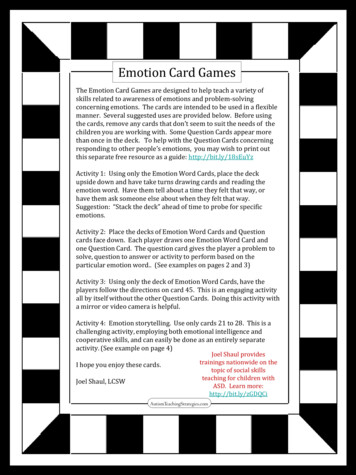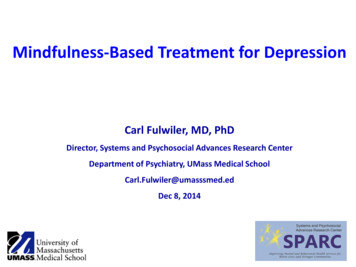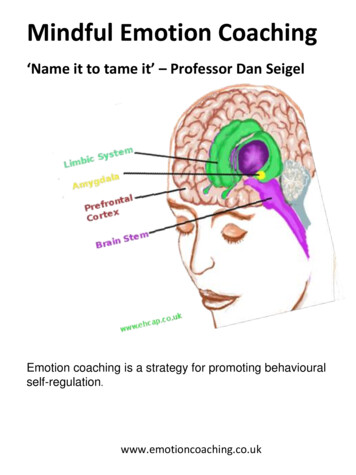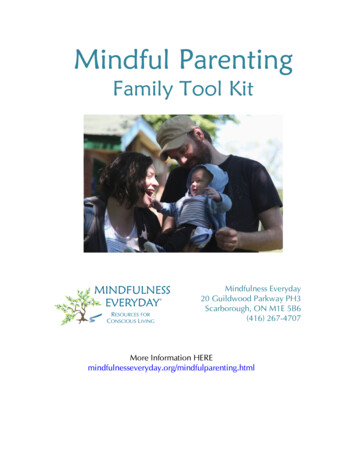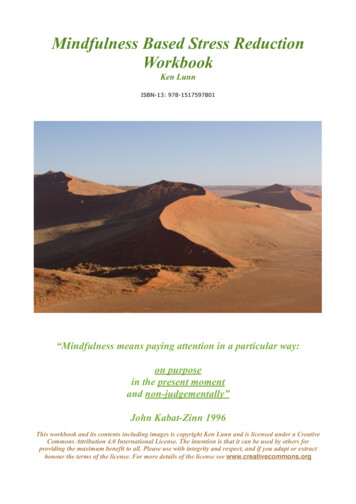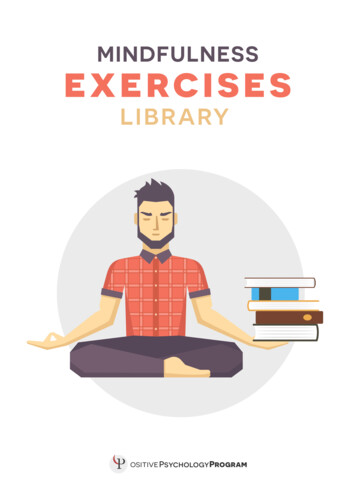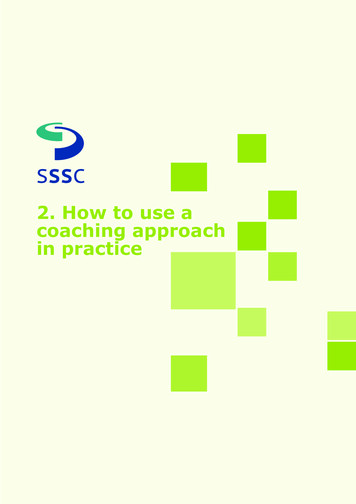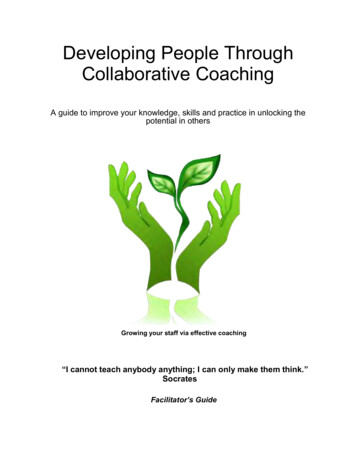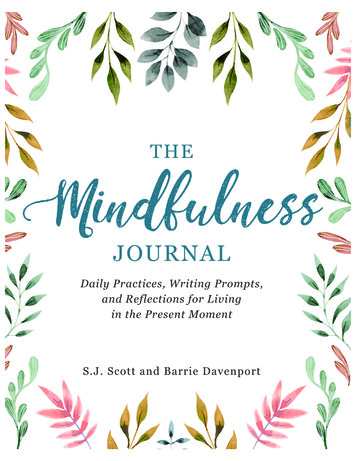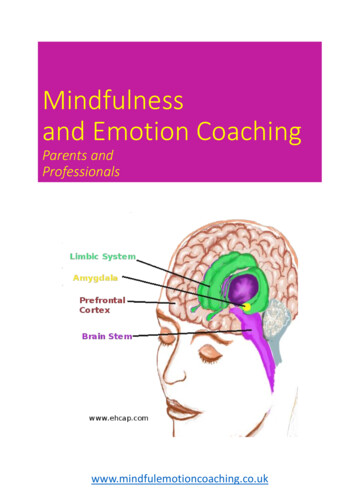
Transcription
Mindfulnessand Emotion CoachingParents andProfessionalswww.mindfulemotioncoaching.co.uk
Evidence base People (including parents and young people) whopractice mindful meditation regularly report feelingless stresses and feeling more emotionallybalanced. According to neuro scientists as youcontinue to meditate your brain physically changes Using brain imaging techniques, changes can beseen in the amygdala – the part of the brain thathelps generate and process feelings and emotionsin response to external stimuli A study at Stanford found that an 8 weekmindfulness course reduced the reactivity of theamygdala – and increased the activity in theprefrontal cortex (an area key to emotionregulation). reference:www.ncbi.nlm.nih.gov/pubmed/20141305
Flipping My Lid &The Hand ModelDr Daniel Siegel is a world famous neuro scientist and Professor in LosAngeles. He has developed The Hand Model of the brain whichincorporates both attachment theory and the neuroscience ofmindfulness.
Flipping My Lid &The Hand Model‘Mindfulness is about being our present moments.We can start cultivating intimacy with our moments by bringingmindfulness to ourselves- ‘how are we feeling?’ As we start to feelourselves we realise we have a chance to stop and come into touchwith ourselves in this moment.’The Healing Power of Mindful Parenting by Jon and Myla Kabat-ZinnDan Siegel’s metaphor – The Hand Model of the Brain - the morewe commit to bringing mindfulness to ourselves the more activitythere will be in our pre frontal cortex or ‘thinking brain’ (acts as a‘brake’ on our emotional reactivity) and the less there will be in ouramygdala or ‘emotional brain’ (acts as an accelerator).
Flipping My Lid &The Hand Model‘Mindfulness is about being our present moments’.The Healing Power of Mindful Parenting by Jon and Myla Kabat-ZinnIn Dan Siegel’s metaphor – The Hand Model of the Brain the closedfist represents the regulated brain – when we make our mosteffective decisions - with the amygdala, pre frontal cortex and brainstem connected. When we are aroused eg angry – we ‘Flip Our Lids’ ,the fingers raise and our pre frontal cortex and amygdala disconnect.Children , Young People and Adults who received synchronous caregiving in early life will find it easier to regulate their emotions and‘bring their lid down’. Mindfulness can help us re connect our prefrontal cortex with our amygdala and brain stem.
Flipping My Lid &The Hand Model‘Mindfulness is about being our present moments’.The Healing Power of Mindful Parenting by Jon and Myla Kabat-ZinnIn Dan Siegel’s metaphor – The Hand Model of the BrainMindfulness can help us re connect our pre frontal cortex with ouramygdala and brain stem.
Emotion Coaching‘Emotion coaching is about helping children and young people to understandthe different emotions they experience, why they occur and how to handlethem’ John GottmanTuning In, Connecting, Empathising, Reflecting are core steps helping usemotionally regulate before problem solvingReferences: Tuning in to Teens – Havighurst, Harley & Kehoe - Mindful, MelbourneUniversity and Tuning in to Kids –Havighurst & Harley, Mindful, Melbourne University
Dr Sarah Temple talks about howMindfulness and EmotionCoaching link upDr Sarah Temple, a GP in Somerset,and Dr Janet Rose, Senior Lecturer atBath Spa University, are co-leading aPublic Health funded Mindful EmotionCoaching Project in Somerset. Detailsof the project are atwww.emotioncoachingsomerset.co.ukReference: Dr Daniel J. Siegel : TheWhole-Brain Child, p.62-63 MindYour Brain, Inc., 2015www.vimeo.com/145252420
The Brain- a summaryYour brain is a like a computer It processes information you get from the world around and tries tomake sense of it.BUTIt is also a Social Organ and it needs other brains to interact withto work at it’s best and for all the different neurones to formhealthy connections (synapses).Different areas are connected together by a network of neuronesthe more you use the network the bigger, better and faster itbecomes.
The Vagus NerveOne of the ways the thinking part of your brain (frontalcortex) works with the brain stem calming your bodilyresponses and helping you stay balanced is via the vagusnerve.The vagus nerve is a cranial nerve which begins in the brainstem and travels to most of our vital organs including ourheart and lungs.Measuring pulse rate is one way of assessing vagal tone.
Evidence base Through non invasive scanning of very youngbabies and children the brain has come to be seenas a ‘social organ’- dependent for normaldevelopment on stimulation through socialinteraction and influenced in a multifactorial wayby other factors including epigenetics, physicalhealth and diet. The importance of inter connectedness andrelationships in human development has beenextensively researched. Key early figures are: John Bowlby, Mary Ainsworth, Mary Main, PatriciaCrittendon
Audio for Mindful RelaxationRead from Tuning in to TeensManual by ChrisChris joined us at a Tuning in to Teens Parenting Group and verykindly made this voice recording of a relaxation exercise
Vimeo Links to Video of Chrisreading Mindful Exercises fromTuning in to Teens Manual https://vimeo.com/150328540 https://vimeo.com/146040577Chris has very kindly made these recordings availablefor us all- thank you Chris
Popular resourcesSitting Like a Frog- Mindfulness Exercises for Kids – Eline SnelIncludes a CD voiced by Myla Kabat-ZinMindfulness for Teachers – Patricia JenningsJust Breathe Video from Mindful.orgwww.emotioncoachingsomerset.co.uk – useful links including DanSiegel The Hand Model on You Tubewww.headspace.com for on line mindful meditation
practice mindful meditation regularly report feeling less stresses and feeling more emotionally balanced. According to neuro scientists as you . Emotion Coaching ZEmotion coaching is about helping children and young people to understand the different e
